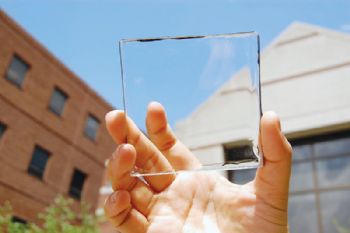
Transparent solar materials that can be applied to windows represent a massive source of untapped energy and could harvest as much power as roof-top solar panels, according to an article in Nature Energy.
The authors — led by engineering researchers at Michigan State University (MSU) (
www.msu.edu) — say that the widespread use of highly transparent solar material, together with the roof-top units, could nearly meet US electricity demand and drastically reduce the use of fossil fuels.
Richard Lunt, associate professor of chemical engineering and materials science at MSU, said: “Highly transparent solar cells represent the future for new solar applications.
"We analysed their potential and found that by harvesting only invisible light, these devices have a similar electricity-generation potential as roof-top solar panels, while providing additional functionality to enhance the efficiency of buildings, automobiles and mobile electronics.”
Professor Lunt and colleagues pioneered the development of a transparent ‘solar concentrator’ that can be placed on a window and harvests solar energy without disrupting the view.
The thin plastic-like material can be used on buildings, car windows, mobile phones and other devices with a clear surface. It uses organic molecules to absorb invisible wavelengths of sunlight.
The authors estimate that this technology has the potential to supply about 40% of the USA’s energy demand — about the same potential as roof-top solar panels.
“The complementary deployment of both technologies could get us close to 100% of our demand, if we also improve energy storage.”
Although transparent solar technologies will never be more efficient at converting solar energy to electricity than their opaque counterparts, they can get close, and they can be applied to a lot more surfaces.
Professor Lunt added: “Traditional solar applications have been actively researched for over five decades, but we have only been working on these highly transparent solar cells for about five years.
"Ultimately, this technology offers a promising route to inexpensive solar adoption on small and large surfaces that were previously inaccessible.”